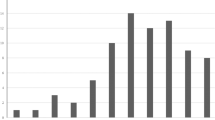Abstract
This work develops a mathematical programming model that characterizes the main variables present in the interaction dynamics of each agent in a collaborative vertical logistical system, such as a supply chain, and measures the synergy level of such system. The model is based on the interaction model developed by the IMP (Industrial Marketing and Purchasing) group and also on the DEA (Data Envelopment Analysis) framework. The basics of these two approaches allow modeling of the characteristics of an agent as well as the collaborative relationships with other agents within the chain. The model was validated using information of supply chain of leather and its products, classified by DANE (Departamento Nacional de Estadistica—Colombia) as the sector CIIU323.
Similar content being viewed by others
References
Barratt, M. A., & Oliveira, A. (2001). Exploring the experiences of collaborative planning: the enablers and inhibitors. International Journal of Physical Distribution and Logistics Management, 31(2), 266–89.
Browning, B., & White, A. (2000). Collaborative transportation management. Logility, Inc. White Paper. http://www.cpfr.org.
Chandra, C., & Kumar, S. (2001). Enterprise architectural framework for supply-chain integration. Industrial Management and Data Systems, 101(5/6), 290–304.
Charnes, A., Cooper, W., & Rhodes, E. (1978). Measuring the efficiency of decision making units. European Journal of Operational Research, 2, 429–444.
Charnes, A., Cooper, W., Golany, W., Seiford, L., & Stutz (1985). Foundation of data envelopment analysis for Pareto-Koopmans efficient empirical production functions. Journal of Econometrics, 30(1–2), 91–107.
Charnes, A., Cooper, W., Lewin, A., & Seiford, L. (1994). Data envelopment analysis: theory, methodology, and applications. Boston: Kluwer Academic.
Chen, Y., & Zhu, J. (2002). Data envelopment analysis interpretation and uses by multiple objective linear programming (Working paper).
Chong, A., Ooi, K., Lin, B., & Tang, S. (2009). A study on impact of Malaysian SMEsInter-organizational relationships and knowledge management towards E-Business supply chain technology implementation. Internet Research, 19(3), 313–331.
Cooke, J. (1998). Into the great wide open. Logistics Management and Distribution Report, 37(10), 84–87.
Dyer, H., & Singh, H. (1998). The relational view: Cooperative strategy and sources of interorganizational competitive advantage. The Academy of Management Review, 23(4), 660–679.
Färe, R., Grosskopf, S., & Lovell, C. (1994). Production frontiers. New York: Cambridge University Press.
Forrester, J. W. (1961). Industrial dynamics. Cambridge: The MIT Press.
Giannakis, M., Croom, S., & Slack, N. (2004). Understanding supply chains: concepts, critiques, and futures. London: Oxford University Press.
Ghiani, G., Laporte, G., & Musmanno, R. (2004). Wiley-Interscience series in systems and optimization. Introduction to logistics systems planning and control. New York: Wiley-Interscience.
Gunnar, S., & Russel, D. (2008). Supply chain interfaces: defining attributes and attribute values for collaborative logistics management. Journal of Business Logistics, 29(1), 347–359.
Hakansson, H., & Ostberg, C. (1975). Industrial marketing: an organizational problem? Industrial Marketing Management, 4, 113–23.
Holmstrom, J., Framling, K., Kaipia, R., & Saranen, J. (2002). Collaborative planning forecasting and replenishment: new solutions needed for mass collaboration. Supply Chain Management, 7(3/4), 136–145.
Hopp, W. J., & Spearman, M. L. (2001). Factory physics: foundations of manufacturing management. New York: McGraw-Hill.
IMP Group (1999). Understanding business marketing and purchasing: an interaction approach (pp. 235–247). Thomson learning.
Jatusripitak, S., Fahey, L., & Kotler, P. (1985). Strategic global marketing: lessons from the Japanese. Columbia Journal of World Business, 20(1), 47.
Kalenatic, D., López, C., & González, L. (2006). Modelo integral de producción en empresas manufactureras. Bogotá: Universidad Católica de Colombia.
Karolefsky, J. (2001). Collaborating across the supply chain. Collaboration in practice. In Food logistics and reailtech magazines (pp. 24–34). Fall 2001.
Lambert, D. M., & Pohlen, T. L. (2001). Supply chain metrics. International Journal of Logistics Management, 12(1), 1–19.
Leontief, W. (1986). Input-output economics. New York: Oxford University Press.
Pramatari, K., Evgeniou, T., & Doukidis, G. (2009). Implementation of collaborative e-supply chain initiatives: an initial challenging and final success case from grocery retailing. Journal of Information Technology, 23(4).
Salmon, K. (1993). Efficient costumer response: enhancing consumer value in the grocery industry. Washington: FMI.
Seifert, D. (2003). Collaborative planning, forecasting, and replenishment: how to create a supply chain advantage. New York: Amacom.
Simatupang, T. M., & Sridharan, R. (2008). Design for supply chain collaboration. Business Process Management Journal, 14(3), 401–418.
Simchi-Levi, D., & Simchi-Levi, E. (2001). Logistics systems modeling. In Handbook of industrial engineering (pp. 2007–2019). New York: Wiley.
Terry, L., & Williams, L. (2003). The value of collaborative transportation management (CTM): its relationship to CPFR and information technology. Transportation Journal, 42(4), 55–65.
Tone, K., & Tsutsui, M. (2009). Network DEA: a slacks-based measure approach. European Journal of Operational Research, 197, 243–252.
Udin, Z., Khan, M., & Zairi, M. (2006). A collaborative supply chain management: Part 2—The hybrid KB/gap analysis system for planning stage. Business Process Management Journal, 12(5), 671–687.
VICS (Voluntary Inter-Industry Commerce Standards Association) (1998). Collaborative planning, forecasting and replenishment (CPFR). http://www.cpfr.org.
Zhu, J. (2002). Quantitative models for performance evaluation and benchmarking: data envelopment analysis with spreadsheets and DEA excel solver. Boston: Kluwer Academic.
Author information
Authors and Affiliations
Corresponding author
Rights and permissions
About this article
Cite this article
Alfonso, E., Kalenatic, D. & López, C. Modeling the synergy level in a vertical collaborative supply chain through the IMP interaction model and DEA framework. Ann Oper Res 181, 813–827 (2010). https://doi.org/10.1007/s10479-010-0694-1
Published:
Issue Date:
DOI: https://doi.org/10.1007/s10479-010-0694-1




